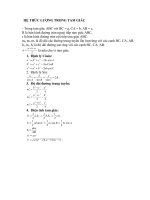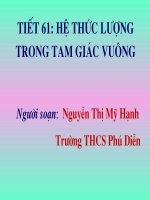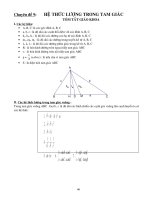Đẳng thức Vector trong tam giác
Bạn đang xem bản rút gọn của tài liệu. Xem và tải ngay bản đầy đủ của tài liệu tại đây (103.22 KB, 6 trang )
On a vector equality
Nguyen Tien Lam
Abstract
In this paper, we recall a vector equality and give some of its applications.
Let us start by introducing the notations that will be used in this paper. By T we
will denote the triangle A
1
A
2
A
3
. The inscribed circle of T has center I and is tanget
to the side opposite to vertex A
i
at B
i
, i = 1, 2, 3. Denote by a
i
and h
i
, i = 1, 2, 3
the lengths of the side opposite to vertex A
i
and the length of the height from that
same vertex, respectively. Let K, p, R, r be the area, semiperimeter, circumradius,
and inradius of T. Denote by K
1
, p
1
, r
1
the area, semiperimeter, and inradius of
B
1
B
2
B
3
.
Theorem. I is the center of mass of the system B
1
, B
2
, B
3
with masses
1
h
1
,
1
h
2
,
1
h
3
or
−−→
IB
1
h
1
+
−−→
IB
2
h
2
+
−−→
IB
3
h
3
= 0. (1)
Proof. We have
A
1
B
2
= A
1
B
3
= p − a
1
, A
2
B
3
= A
2
B
1
= p − a
2
, A
3
B
1
= A
3
B
2
= p − a
3
.
It is not difficult to prove that for every point M on the side A
i
A
j
, i = j, i, j ∈
{1, 2, 3} we have
−−→
IM =
MA
j
A
i
A
j
·
−−→
IA
i
+
MA
i
A
i
A
j
·
−−→
IA
j
.
When M = B
1
we get
−−→
IB
1
=
B
1
A
j
A
i
A
j
·
−−→
IA
i
+
B
1
A
i
A
i
A
j
·
−−→
IA
j
or equivalently a
1
−−→
IB
1
= (p −a
3
)
−−→
IA
2
+ (p −a
2
)
−−→
IA
3
. Similarly, we obtain
a
2
−−→
IB
2
= (p −a
1
)
−−→
IA
3
+ (p −a
3
)
−−→
IA
1
and
a
3
−−→
IB
3
= (p −a
2
)
−−→
IA
1
+ (p −a
1
)
−−→
IA
2
.
Adding the above equalities side by side, we obtain
a
1
−−→
IB
1
+ a
2
−−→
IB
2
+ a
3
−−→
IB
3
= (2p −a
2
−a
3
)
−−→
IA
1
+ (2p −a
3
−a
1
)
−−→
IA
2
+ (2p −a
1
−a
2
)
−−→
IA
3
.
Mathematical Reflections 6 (2008) 1
Note that 2p = a
1
+ a
2
+ a
3
and recall that a
1
−−→
IA
1
+ a
2
−−→
IA
2
+ a
3
−−→
IA
3
= 0, thus
a
1
−−→
IB
1
+ a
2
−−→
IB
2
+ a
3
−−→
IB
3
= 0.
Using the formula a
i
=
2K
h
i
we conclude that
−−→
IB
1
h
1
+
−−→
IB
2
h
2
+
−−→
IB
3
h
3
= 0.
Alternative proof. For i = 1, 2, 3 we know that
−−→
IB
i
IB
i
is a unit vector perpendicular to
the side opposite to vertex A
i
, its direction being out of the triangle. By applying
the “Porcupine Theorem” we obtain
a
1
−−→
IB
1
IB
1
+ a
2
−−→
IB
2
IB
2
+ a
3
−−→
IB
3
IB
3
= 0.
Note that IB
1
= IB
2
= IB
3
= r and by using the formula a
i
=
2K
h
i
, i = 1 , 2, 3 we
deduce that
−−→
IB
1
h
1
+
−−→
IB
2
h
2
+
−−→
IB
3
h
3
= 0.
The proof is thus c omplete and we are ready to show som e of the results due to this
theorem.
Problem 1. Prove that
B
1
B
2
2
h
1
h
2
+
B
2
B
3
2
h
2
h
3
+
B
3
B
1
2
h
3
h
1
= 1. (2)
Solution. By squaring both sides of the equation (1) and using the following identity
2
−−→
IB
i
−−→
IB
j
= IB
i
2
+ IB
j
2
− B
i
B
j
2
= 2r
2
− B
i
B
j
2
we obtain
3
i=1
1
h
2
i
+ 2 ·
3
i=1
1
h
i
h
j
r
2
−
B
1
B
2
2
h
1
h
2
+
B
2
B
3
2
h
2
h
3
+
B
3
B
1
2
h
3
h
1
= 0.
Using the fact that
1
h
1
+
1
h
2
+
1
h
3
=
1
r
it follows that
B
1
B
2
2
h
1
h
2
+
B
2
B
3
2
h
2
h
3
+
B
3
B
1
2
h
3
h
1
= 1.
We will now present four corollaries following from Problem 1.
Mathematical Reflections 6 (2008) 2
Corollary 1. The following inequality holds
a
1
a
2
B
1
B
2
+ a
2
a
3
B
2
B
3
+ a
3
a
1
B
3
B
1
≤
4
√
3
3
pK. (3)
Solution. Knowing that a
i
=
2K
h
i
, we can rewrite the inequality in the form
4K
2
B
1
B
2
h
1
h
2
+
B
2
B
3
h
2
h
3
+
B
3
B
1
h
3
h
1
≤
4
√
3
3
pK.
Because K = pr, the above inequality becomes
B
1
B
2
h
1
h
2
+
B
2
B
3
h
2
h
3
+
B
3
B
1
h
3
h
1
≤
√
3
3r
.
We will now prove that the last inequality is true. Indeed, by applying the Cauchy-
Schwarz inequality we obtain
B
1
B
2
h
1
h
2
+
B
2
B
3
h
2
h
3
+
B
3
B
1
h
3
h
1
2
≤
1
h
1
h
2
+
1
h
2
h
3
+
1
h
3
h
1
B
1
B
2
2
h
1
h
2
+
B
2
B
3
2
h
2
h
3
+
B
3
B
1
2
h
3
h
1
.
By using the well-known inequality ab + bc + ca ≤
1
3
(a + b + c)
2
for all real number
a, b, c and the equality
1
h
1
+
1
h
2
+
1
h
3
=
1
r
it follows, from Problem 1, that
B
1
B
2
h
1
h
2
+
B
2
B
3
h
2
h
3
+
B
3
B
1
h
3
h
1
2
≤
1
3r
2
or equivalently
B
1
B
2
h
1
h
2
+
B
2
B
3
h
2
h
3
+
B
3
B
1
h
3
h
1
2
≤
√
3
3r
.
The equality takes places if and only if T is an equilateral triangle.
Corollary 2. If T is an acute triangl, then
max{a
1
, a
2
, a
3
} ≥
√
3R (4)
with equality if and only if T is an equilateral triangle.
Solution. Draw three lines tanget to the circle circumscribed around T from its
vertices. Suppose that these three lines intersect at three points C
1
, C
2
, and C
3
where C
i
is the vertex opposite to the side passing through A
i
, i = 1, 2, 3. The circle
circumscribed to T is the incercle of C
1
C
2
C
3
. Thus R is the length of the inradius of
C
1
C
2
C
3
. Denote by l
1
, l
2
, and l
3
the lengths of the altitudes in the triange C
1
C
2
C
3
.
Applying the result of Problem 1 we obtain
A
1
A
2
2
l
1
l
2
+
A
2
A
3
2
l
2
l
3
+
A
3
A
1
2
l
3
l
1
= 1
Mathematical Reflections 6 (2008) 3
or
a
3
2
l
1
l
2
+
a
1
2
l
2
l
3
+
a
2
2
l
3
l
1
= 1.
Hence
1 ≤ max{a
2
1
, a
2
2
, a
2
3
} ·
1
l
1
l
2
+
1
l
2
l
3
+
1
l
3
l
1
≤
1
3
max{a
2
1
, a
2
2
, a
2
3
}
1
l
1
+
1
l
2
+
1
l
3
2
.
Note that
1
l
1
+
1
l
2
+
1
l
3
=
1
R
, thus it follows that
1
3R
2
max{a
2
1
, a
2
2
, a
2
3
} ≥ 1
and we conclude that
max{a
1
, a
2
, a
3
} ≥
√
3R.
Equality occurs if and only if l
1
= l
2
= l
3
and thus C
1
C
2
= C
2
C
3
= C
3
C
1
. This
imples that C
1
C
2
C
3
is equilateral which in turn means that A
1
A
2
A
3
is equilateral,
and we are done.
Corollary 3.
p
2
1
≤
pK
2R
. (5)
When does equality occur ?
Solution. We introduce the following inequality
a
2
x
+
b
2
y
+
c
2
z
≥
(a + b + c)
2
x + y + z
for all pos itive reals a, b, and c to prove the above inequality with equality if and
only if
a
x
=
b
y
=
c
z
. Using the above inequality and the result of Problem 1 we
obtain
1 =
B
1
B
2
2
h
1
h
2
+
B
2
B
3
2
h
2
h
3
+
B
3
B
1
2
h
3
h
1
≥
(B
1
B
2
+ B
2
B
3
+ B
3
B
1
)
2
h
1
h
2
+ h
2
h
3
+ h
3
h
1
.
Observe that B
1
B
2
+ B
2
B
3
+ B
3
B
1
= 2p
1
and
h
1
h
2
+ h
2
h
3
+ h
3
h
1
= 4K
2
1
a
1
a
2
+
1
a
2
a
3
+
1
a
3
a
1
=
8K
2
p
a
1
a
2
a
3
.
By using the formulae K =
a
1
a
2
a
3
4R
and h
1
h
2
+ h
2
h
3
+ h
3
h
1
=
2Kp
R
it follows that
p
2
1
≤
pK
2R
.
Equality occurs if and only if
B
1
B
2
h
1
h
2
=
B
2
B
3
h
2
h
3
=
B
3
B
1
h
3
h
1
or
a
1
a
2
B
1
B
2
= a
2
a
3
B
2
B
3
= a
3
a
1
B
3
B
1
.
Mathematical Reflections 6 (2008) 4
Because a
1
a
2
B
1
B
2
= a
2
a
3
B
2
B
3
then a
2
1
B
1
B
2
2
= a
2
B
2
B
3
2
. By the Law of Cosines
we obtain
B
1
B
2
2
= 2(p −a
3
)
2
(1 −cos A
3
) = 2(p −a
3
)
2
1 −
a
2
1
+ a
2
2
− a
2
3
2a
1
a
2
.
Therefore
B
1
B
2
2
=
4(p −a
3
)
2
(p −a
1
)(p −a
2
)
a
1
a
2
.
Similarly
B
2
B
3
2
=
4(p −a
1
)
2
(p −a
2
)(p −a
3
)
a
2
a
3
.
Thus, the inequality a
2
1
B
1
B
2
2
= a
2
B
2
B
3
2
is equivalent to a
1
(p − a
3
) = a
3
(p − a
1
)
and so a
1
= a
3
. Analogously we deduce that a
2
= a
3
. Consequantly a
1
= a
2
= a
3
which proves that T is equilateral and we are done.
Corollary 4. Let O be the circumcenter of T. Then
OB
1
h
1
+
OB
2
h
2
+
OB
3
h
3
≤
R
r
− 1. (6)
Solution. By using (1) and the equality
1
h
1
+
1
h
2
+
1
h
3
=
1
r
we obtain
−→
OI = r
−−→
OB
1
h
1
+
−−→
OB
2
h
2
+
−−→
OB
3
h
3
.
On squaring both sides and using the identity 2
−−→
OB
i
−−→
OB
j
= OB
i
2
+OB
j
2
−B
i
B
j
2
, i, j =
1, 2, 3 we get
OI
2
= r
2
3
i=1
OB
i
2
h
2
i
+
1≤i<j≤3
OB
i
2
+ OB
j
2
h
i
h
j
+
1≤i<j≤3
B
i
B
j
2
h
i
h
j
.
By using the result from Problem 1 and Euler’s theorem OI
2
= R
2
−2Rr it follows
that
OB
1
2
h
2
1
+
OB
2
2
h
2
2
+
OB
3
2
h
2
3
+
OB
1
+ OB
2
2
h
1
h
2
+
OB
2
+ OB
3
2
h
2
h
3
+
OB
3
+ OB
1
2
h
3
h
1
=
R
r
− 1
2
.
Because OB
i
2
+ OB
j
2
≥ 2OB
i
OB
j
, i, j = 1, 2, 3 and the identity (a + b + c)
2
=
a
2
+ b
2
+ c
2
+ 2ab + 2bc + 2ca we obtain
OB
1
h
1
+
OB
2
h
2
+
OB
3
h
3
≤
R
r
− 1
2
.
Mathematical Reflections 6 (2008) 5
Since R ≥ 2r > r we obtain the desired result. Equality occurs if and only if T is
an equilateral triangle.
Problem 2. Prove that
MB
1
h
1
+
MB
2
h
2
+
MB
3
h
3
≥ 1 (7)
for all points M.
Solution. We will use the follwing two facts |
−→
u | · |
−→
v | ≥
−→
u ·
−→
v and
−−−→
MB
i
=
−−→
MI +
−−→
IB
i
, i = 1, 2, 3 to obtain
3
i=1
MB
i
h
i
≥
1
r
3
i=1
−−−→
MB
i
−−−→
MB
i
h
i
=
1
r
3
i=1
IB
i
h
i
−−→
MI + r
3
i=1
1
h
i
.
The desired inequality follows if we keep in mind that
1
h
1
+
1
h
2
+
1
h
3
=
1
r
. Equality
occurs if and only if M = I.
Problem 3. Prove that
MB
1
2
h
1
+
MB
2
2
h
2
+
MB
3
2
h
3
=
MI
2
r
+ r (8)
for all points M in the plane.
Solution. We have
3
i=1
MB
i
2
h
i
=
3
i=1
−−→
MI +
−−→
IB
i
h
i
= MI
2
3
i=1
1
h
i
+ 2
3
i=1
−−→
IB
i
h
i
−−→
MI +
3
i=1
IB
i
2
h
i
.
Thus,
3
i=1
MB
i
2
h
i
=
MI
2
r
+ r
and we are done
References
[1] Viktor Prasolov, 2006, Problems in plane and solid geometry ( translated and
edited by Dimitry Leites.)
[2] Kiran S.Kedlaya, 2006, Geometry Unbound.
[3] Nguyen Minh Ha, 2005, Toan nang cao hinh hoc 10, Education Publishing
House, Hanoi, Vietnam.
[4] Euler Triangle Formula,
/>Mathematical Reflections 6 (2008) 6









